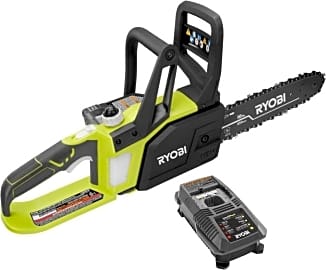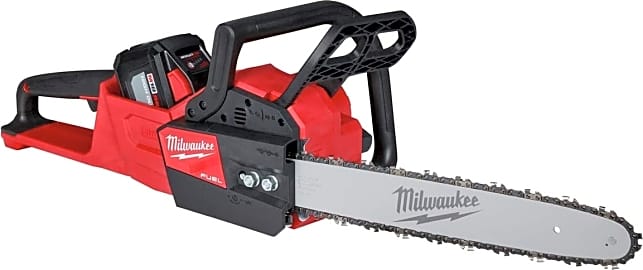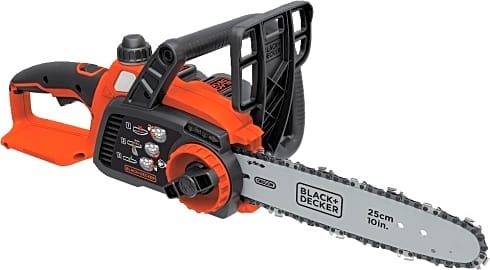The 10 Best Electric Chainsaws

This wiki has been updated 40 times since it was first published in July of 2015. Getting through gardening chores is a whole lot easier with one of these electric chainsaws, which are much less noisy and messy than their gasoline-powered counterparts. We've included corded and battery-powered options, budget-priced models good for smaller tasks, and powerful units that make light work of the thickest logs. Always use care and the right safety equipment when working with these. When users buy our independently chosen editorial picks, we may earn commissions to help fund the Wiki.
Editor's Notes
November 01, 2020:
For this update, we replaced the Remington Ranger due to some chain durability issues, and the fact that it's more of a pole saw than a chainsaw, and we wanted to make room for an option that better suited the category. Since we only had one 16-inch corded option to choose from, the Makita UC4051A, we added a more budget-friendly option, the Wen 4017. The Wen 4017 weighs just 10 pounds, and has a nice bright orange color. As someone who's worked on large landscaping projects that had a lot of chainsaws present, I personally feel that high-visibility orange makes equipment -- and job sites -- a little bit safer.
We also replaced the Worx JawSaw with a more typical chainsaw style, the Milwaukee 2727. What's great about the Milwaukee 2727 is that it accepts the same M18 batteries as other Milwaukee power tools. So, if you already have a collection of Milwaukee brand drills, saws, or lighting equipment, you'll have a good supply of extra batteries already. Since the biggest limitation of battery-powered chainsaws is their limited running time, this could be a huge benefit for the right person. At about 15 pounds, this model wouldn't be ideal for users who don’t have the strength or the need for such a heavy-duty machine.
Be sure to carefully read the instruction and user manual for any chainsaw you buy, and take the time to research safe habits and operating procedures. Chainsaws, electric or not, are one of the most dangerous pieces of equipment you can buy, and require more skill to operate safely than you might think. If you don't have a professional to consult, online videos are a great way to get more insight on ways to use your chainsaw safely and effectively.
You'll need to regularly maintain your chainsaw to keep it in working order. Follow the care instructions included, and keep your chainsaw teeth looking and feeling new with a dedicated chainsaw sharpener.
If you're more interested in lopping off tree branches higher than you can reach, a pole saw is probably a better option for you.
April 14, 2019:
Starting gas-powered tools is no picnic, and thanks to modern electrical technology, most people are no longer forced to hunch over smelly, dangerous 2-cycle motors and hurt their back trying to pull the starter cord. Right off the bat, know that the Makita is a fantastic replacement for most older models, and while it is pretty costly, it's more powerful and has a larger cutting capacity than most of the rest. The 40-volt Black and Decker is also surprisingly powerful for a battery-operated model, and while the 20-volt version isn't quite as strong, it's just as well made. The GreenWorks and Ryobi are also in similar classes.
But if you're okay with having a cord, there are some really interesting options that can fit specialized applications well. The Remington is designed to remove still-standing branches while you're on the ground, though it can get heavy after a while. The Black and Decker Alligator is a clever hybrid that adds support and side-pressure, which can save your arms from overexertion. The Worx JawSaw is another unique model whose construction keeps it from jumping around, while letting you slice through wood by pushing it, rather than pulling it through the logs and toward the ground where your feet happen to be. Finally, the Worx and the Oregon plug-in models are low- and moderately priced, respectively, and perform quite well enough for most residential applications.
No matter what, as with all power tools, you'll need the right safety equipment, as well as attention to the task at hand. We'd suggest gloves, goggles, durable work boots, and possibly even a hardhat if you'll be cutting down overhead branches. Always pay attention to what you're doing, and be certain that anyone using the tools is strong enough to do so, and has had sufficient training.
It's Electric: Choosing A Chainsaw
If you're felling trees, you need a chainsaw with a large, long bar.
Electric chainsaws are clean and easy to operate, with none of the gasoline and oil blending their combustion-engine-powered counterparts require, and none of the accompanying odors or spills, either. These saws also start up without that annoying pull-cord mechanism, and can be shut off more easily as well. And thanks to the many powerful battery operated chainsaws on the market today, no longer are these electric tools limited to the length of your extension cord.
Once you have committed to buying an electric chainsaw, the first decision you should make is whether you want a battery powered or a corded tool. A battery powered chainsaw can go anywhere at any time and is quite convenient, right up to the moment at which its battery runs out of juice, anyway. You can mitigate this issue by purchasing a second battery, but if you have a lot of cutting to do, even with one battery charging while the other is at work, chances are good that you will have a fair amount of downtime waiting for a recharge.
So balance the convenience of full portability with the patience needed for charging batteries. With the lack of range inherent in a plug in chainsaw comes the fact that it will never run out of power barring a blackout. (Even gasoline chainsaws require a pause for refilling.)
The next issue to consider, regardless of power source, is the blade length you need. If you're felling trees, you need a chainsaw with a large, long bar. For true timber cutting, consider models with at least a sixteen-inch bar, or better yet, look for eighteen-inch bar chainsaws. If you're more concerned with chopping up limbs to fit them in a dumpster or wood chipper or with cutting down fallen logs into firewood, a shorter blade should suffice.
Safe And Proper Tree Felling With A Chainsaw
Used properly, chainsaws are not dangerous to their operator or anyone nearby. Used improperly, chainsaws are incredibly dangerous devices. This danger stems not only from the actual whirling blade protruding from the tool's powerful motor, but also from the chance for improperly felled trees or limbs to cause injury -- in fact some studies show that nearly 90 percent of chainsaw-related deaths resulted not from contact with the tool itself but from the impact of a tree trunk or branch.
Used improperly, chainsaws are incredibly dangerous devices.
The most common source of injury with a chainsaw is from kickback when the saw encounters an area of material, such as a knot, through which it cannot immediately cut. The chain catches and transfers its energy to the tool itself, sending the chainsaw bouncing upward toward the operator. To minimize the chance of a dangerous kickback, never cut with the tip of the saw and avoid cutting with the first few inches of the top of the blade. Also always make sure both of your hands are firmly grasping the saw before you make contact with lumber.
To properly cut down a small or medium sized tree (leave larger trees to the experts), first cut a wedge shaped notch in the direction you wish the tree to fall. This wedge, often called an undercut, should be cut into the side of the tree toward which it is likely to fall based on its shape or its location on a slope. To fell your prepared tree, slowly and steadily cut into it across from the undercut, ceasing your action before you have cut all the way through the tree.
Leaving this hinge of wood prevents the tree from jumping off of its stump, potentially causing serious injury. Now move well away from the tree and bring it down using ropes or pressure applied by poles once everyone is away from the trunk and out of the tree's downward path.
The Other Gear You Should Get
If you're using a chainsaw properly, you're also using several other pieces of gear at the same time. The most obvious and necessary item you should be using at all times when operating a chainsaw is a pair of safety glasses or **goggles. A chainsaw sends dust and scraps of wood flying; the former can irritate your eyes, while the latter can cause a serious injury, scratching the cornea or worse. To put it simply, you should never use a chainsaw without something covering your eyes.
No one ever plans to drop a chainsaw or have the blade buck wildly, but if either of those things happen, you'll be glad you were wearing the right gear for the occasion.
The next thing the savvy chainsaw operator uses is hearing protection. A set of safety earmuffs is the best way to protect your ears while operating a noisy chainsaw, but a pair of regular earplugs is better than nothing if need be.
While your hands should be totally safe from cuts while you operate a chainsaw (provided you are using the tool properly), a pair of protective work gloves is still a smart choice during chainsaw use. Gloves protect your hands from scratches or cuts resulting from rough pieces of wood or from debris sent flying by the saw, and can help you maintain a firm and comfortable grip on the tool and/or on any lumber or timber you need to cut through.
Finally it's a good idea to wear sturdy work boots and a good pair of thick bluejeans (or other durable pants). No one ever plans to drop a chainsaw or have the blade buck wildly, but if either of those things happen, you'll be glad you were wearing the right gear for the occasion.















